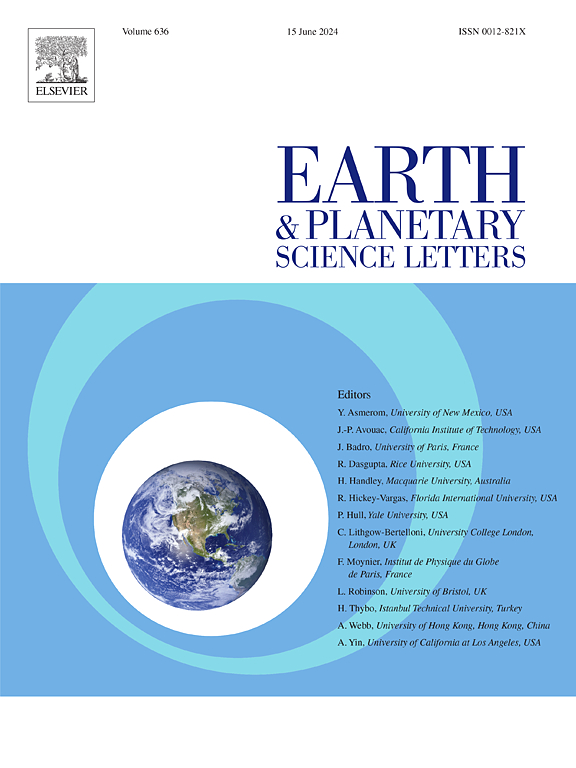Stable silicon isotope fractionation reflects the routing of water through a mesoscale hillslope
IF 4.8
1区 地球科学
Q1 GEOCHEMISTRY & GEOPHYSICS
引用次数: 0
Abstract
Concentration - isotope Ratio - Discharge (C-R-Q) relationships offer a promising means of disentangling the underlying hydrologic, geochemical, and ecological factors that produce variations in stream solute chemistry across a variety of critical zone systems. However, natural environments are both temporally and spatially complex, and prevailing interpretations of these C-R-Q patterns remain difficult to validate. Here we employ three replicate artificially constructed hillslopes at the Landscape Evolution Observatory (LEO) in Tucson, Arizona as simplified analogs to natural catchments. LEO allows us to record silicon stable isotope (δ30Si) signatures of fluid discharge under a controlled irrigation schedule in a system devoid of vegetation. This unique meso‑scale experiment enables, for the first time, evaluation of metalloid stable isotope signatures at the scale of natural hillslopes constrained to known fluid transit time distributions (TTDs) and limited to fractionation in association with secondary mineral formation. We report δ30Si in discharge samples collected over three randomized storm events of varying intensity. The data reflect consistent enrichment in the fluid phase between +1.00 and +2.07 ‰ across the three hillslopes, despite highly variable irrigation scenarios, reflecting substantial loss of SiO2 from solution due to secondary mineral precipitation. We compare results from an isotope-enabled Reactive Transport Model (RTM) and the discharge measurements from LEO to constrain the contributions of both characteristic watershed TTDs and fractionation pathways in emergent δ30Si signatures. Our study confirms and expands upon recent work in natural systems attributing intra-site variability in silicon stable isotope signatures to the routing of fluid through catchments.
稳定的硅同位素分馏反映了水流通过中尺度山坡的路线
浓度-同位素比值-排水量(C-R-Q)关系提供了一种很有希望的方法,可用于区分在各种临界区系统中产生溪流溶质化学变化的基本水文、地球化学和生态因素。然而,自然环境在时间和空间上都很复杂,对这些 C-R-Q 模式的普遍解释仍然难以验证。在这里,我们利用亚利桑那州图森市景观演变观测站(LEO)的三个人工建造的山坡作为自然集水区的简化模拟。通过 LEO,我们可以在一个没有植被的系统中,在受控灌溉计划下记录流体排放的硅稳定同位素(δ30Si)特征。这一独特的中尺度实验首次实现了在天然山坡尺度上对金属类稳定同位素特征的评估,这种评估受制于已知的流体通过时间分布(TTD),并局限于与次生矿物形成相关的分馏。我们报告了在三个不同强度的随机暴雨事件中收集的排放样本中的δ30Si。尽管灌溉方案变化很大,但数据反映出三个山坡的流体相在 +1.00 和 +2.07 ‰ 之间的富集程度是一致的,这反映出由于次生矿物的沉淀,溶液中的二氧化硅大量流失。我们比较了同位素激活的反应迁移模型(RTM)和 LEO 的排放测量结果,以确定特征流域 TTD 和分馏途径在出现的 δ30Si 特征中的贡献。我们的研究证实并扩展了最近在自然系统中开展的工作,这些工作将硅稳定同位素特征的场内变异归因于流体通过集水区的路径。
本文章由计算机程序翻译,如有差异,请以英文原文为准。
求助全文
约1分钟内获得全文
求助全文
来源期刊

Earth and Planetary Science Letters
地学-地球化学与地球物理
CiteScore
10.30
自引率
5.70%
发文量
475
审稿时长
2.8 months
期刊介绍:
Earth and Planetary Science Letters (EPSL) is a leading journal for researchers across the entire Earth and planetary sciences community. It publishes concise, exciting, high-impact articles ("Letters") of broad interest. Its focus is on physical and chemical processes, the evolution and general properties of the Earth and planets - from their deep interiors to their atmospheres. EPSL also includes a Frontiers section, featuring invited high-profile synthesis articles by leading experts on timely topics to bring cutting-edge research to the wider community.
 求助内容:
求助内容: 应助结果提醒方式:
应助结果提醒方式:


